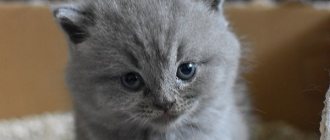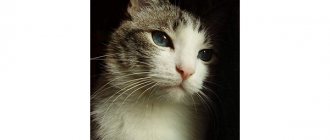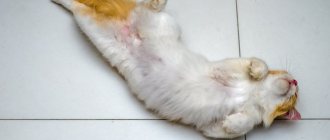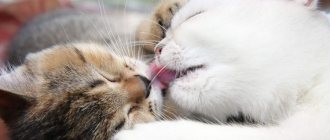Cats can imitate small children
All cats “communicate” with their owner with a characteristic meow. When a cat meows, it wants to say something to a person, for example: “Feed me!”, “Pay attention to me!”, “I did something, go clean it up!”
When communicating, cats use different tones and different levels of “volume” of their sounds. Few people know, but with the help of these sounds cats manipulate their owners.
Research by scientists has shown that the cry of a hungry cat, in frequency, resembles the cry of a hungry baby. This is surprising, because this discovery showed that this phenomenon is not just a coincidence. And the real “cunning” of four-legged fluffies. Over the years, cats have learned to use the frequency of sound that people respond to faster. But you must admit that these sounds do not irritate you, but evoke natural instincts, which prompt you to go and feed the cat. Incredible, right?
Domestic cat - behavior: if it is hungry
Domestic cat
The domestic cat does not hide its feeling of hunger; it will definitely inform its owner about it. Behavior if she is hungry:
- The cat will walk around you, not allowing you to pass until it gets what it wants.
- He doesn't take his eyes off, lifts his muzzle and tail high, and rubs his whole body against your legs.
- Depending on its character, the pet will also remind you with its voice that it needs to be fed.
There are other situations - for example, you started watching TV, simultaneously taking some goodies with you. Such food may be completely inedible for cats, but they may not understand this. Regardless of the food a person consumes, cats will beg for exactly what their owner eats.
To show a person about his feeling of hunger or to beg for a tasty treat, the cat will use various tricks and tricks:
- He will rest his forehead
- It will purr, singing sweet songs
- Will make your eyes round
- Blackmail and beg your master with all your might
If a person continues to ignore the cat’s wishes, he will not be shy and can steal the treasured piece, no matter where from – from a plate or from his hands.
The cat family, regardless of size, is a nocturnal animal. During the day or evening, the cat can sleep well and remain awake at night. They will demand breakfast early, as soon as they wake up at four in the morning they inform the owner of their hunger. If the bedroom is closed, with a high degree of probability they will try to call the owner through the door, and if it is open, they will look for you through the blanket, methodically poking you with their paws.
To correct this situation, it is recommended to leave some of the food before bedtime so that the cat can eat during the night. If you don’t do this, you will have to listen to begging requests throughout the night. Many people can’t stand it and get up early in the morning to feed their pet.
A cat buries its excrement so as not to offend anyone
Many people who have cats in their apartment know that after the pet has gone to the toilet, it intensively buries everything. It looks like the cat is performing these actions instinctively, but there is a reason for these actions.
This behavior was inherited by cats from their ancestors. Even before cats were domesticated, they had many dangerous enemies. And so that their enemies would not find them, the cats buried all their tracks.
Also, cats buried everything they did so as not to offend the dominant male of their group. Therefore, by burying their excrement, cats show their owner that they are afraid of him. As soon as the four-legged pet stops doing this, it will mean that he is no longer afraid of you.
Harmful cat habits
Not all cat habits are liked by owners; some habits create difficulties for people keeping a pet in an apartment:
Scratching furniture
Sharpening their claws is a natural need, this is how animals remove excess length and clean off the stratum corneum. It is necessary to install a scratching post and teach the cat to use it, strictly preventing attempts to tear up furniture, wallpaper, carpets, and floor coverings.
Tags
Sexually mature cats leave fragrant business cards on the corners of walls, legs of tables, and cabinets. This is how they indicate their right to territory and declare to females that they are ready to mate.
The acrid smell of the secretion is difficult to evaporate, absorbing into the surface. To avoid an unpleasant spirit in the house, to save yourself from unnecessary suffering, and the animal from illness, attempts to break free, it is recommended to castrate the cat. Especially if the owners do not plan to engage in breeding.
Eating out
Cats walking outside on their own can eat offerings from compassionate passers-by and food waste. Stale food causes poisoning, infectious diseases, indigestion, and vomiting. Particularly dangerous are the linings of “cathunters” stuffed with crushed glass and the points of fishing hooks.
Utility companies leave out poisonous food to kill rats, but cats can also fall prey to coumarin. It is necessary to feed your pet well before leaving, and it is better to prevent self-walking.
Be sure to read:
Why cats leave home to die: 5 reasons, where they go, how they behave before death
Why do cats rub against human legs?
Cats masterfully hide their feelings, and rejoice at their owner in a completely different way than dogs do. You can “read” complete indifference on their face. Almost all cat owners notice that their pet periodically rubs against their legs, as if hugging them. People are happy about this and believe that this is a sign of love from the pet. However, everything is not like that, and few people know that when a cat rubs against a person, it marks him and claims him as his property.
Cats, like other animals, secrete unique pheromones, and this smell is felt only by members of the feline family. Therefore, when a cat rubs against its legs, it leaves its scent on the owner, thereby warning other cats that you are his property.
More strange behavior
Some “weirdness” is not a deviation from the norm - it is nature. The cat has found itself in unfamiliar territory, where everything is “foreign.” It is necessary to examine every corner and apply your own scent. In a word, “mark” the territory. Do not prevent a cat that is carefully exploring the house from rubbing its back or face against some objects or things. Don’t be surprised when your pet suddenly craves love and affection - it will spin around you, get under your feet, and “butt” its face. In fact, this is how a defensive psychological reaction works: the animal is nervous, huddles close to its owners, as if waiting for confirmation: nothing terrible has happened, everyone is alive and well, safe. Be sure to caress and stroke the cat at such a difficult moment!
Why do cats hiss when they sense danger?
Many people have repeatedly witnessed “cat fights.” When a cat attacks an enemy, it presses itself to the floor, lowers its ears and emits a terrible hiss. This is explained by the fact that cats are able to imitate and imitate various sounds. Therefore, smart animals chose to imitate a creature that they are practically afraid of - a poisonous snake. The cunning cat's brain understands that hissing is intuitively associated with a snake. That is why, in order to scare the enemy, the cat hisses.
The cat is “kneading the dough” again
And very active! Meows, jumps on your lap, purrs, sitting on your lap. Moreover, he “kneads the dough”, which has not been observed for a long time. What is this – an expression of joy from moving? No - this is also a defensive reaction. “Kneading dough” is a behavior inherited by the kitten from distant childhood, when he was close to his mother. The cat is now looking for your sympathy and consolation. We see no reason to refuse an animal such a request! Just “spread some straws” - put on a thick tracksuit or something like that. Your knees shouldn't suffer!
How to explain the fact that cats constantly wash themselves?
Cats are the cleanest creatures, because they wash themselves after every meal, after any careless movement, and just like that. And after the owner strokes the pet, the cat licks its “fur coat” for a very long time. This is explained by the fact that in this way the cat washes away the smell left by the person.
When cats lick fur, special glands are activated, which remove all foreign odors. A cat always wants to smell itself.
By the way, if you often bring guests to your house, your pet may start urinating anywhere. Thus, he wants to remove the smells of strangers, thereby showing that there is already an owner in this house, his owner.
Adaptation of a cat to a new home (including foster care)
Rules for dating cats
1) A separate room with all the necessary accessories should be prepared for the new cat, where she will live until she meets other cats for a couple of weeks. During this period, the cat should first get used to you without seeing other cats in the house. At the same time, cats can already hear and know that there is someone new in the house. If cats show anxiety at this time, move them away from the door of the “secret room”.
2) Smell is very important for cats. A new family member should be introduced to the smell gradually. To do this, animal psychologists use the “sock” method - when they take two socks, maybe of different colors, so as not to confuse them, and stroke one cat with one sock, and another cat with the other sock. You need to stroke the muzzle, antennae, ears, and around the tail. Then the socks are placed on the other cat for familiarization and left, periodically updating the scent of the other cat with her sock. Don't rub your cat with another cat's sock! If cats do not show a negative reaction to a new smell, you should definitely praise them and give them a treat.
3) If everything goes smoothly, the next step will be to introduce the new cat to the territory of the owner cat. In this case, your cat should be moved out of sight and into another room. The new cat will begin to sniff the new territory and continue to become familiar with the smells. Do not touch the cat at this moment. After a few days of such procedures, you can start playing with the cat in this territory so that she quickly adapts and feels confident in the new territory.
4) Once the new cat has relaxed in the new territory, you can swap the cats. Again, no eye contact. Your cat is placed in a secret room where she calmly becomes familiar with the scents of her new cat. Give your cat attention in this room and distract her with pleasant things, such as games or treats. The new cat continues to explore another territory. Increase the time you spend in different rooms every day.
5) Once your cat begins to feel confident and does not show anxiety when being in a secret room with someone else's smell, you can move on to the next step - visual contact. But you cannot connect cats nose to nose. You can call this step the “peeping stage.” Your task is to avoid conflicts. It is important that cats cannot rush at each other. Therefore, at first it will be a short visual contact at a distance, for example, through a small crack in the door. Cats can be held in your arms at this moment. Start with a few seconds, increasing the time of eye contact at a distance every day. Distract the cat from the negative reaction - immediately break off visual contact and calm the cat, turning its attention to you. Encourage a calm reaction by treating him with treats and games. Cats should only have positive impressions from such contacts.
6) Gradually increase eye contact by opening the door wider, bringing the cats closer to the crack, until you achieve a calm reaction without growling or hissing from both cats. Don't rush things. Only after this can the cats be connected. Each cat should still have its “property” - a bed, toys, bowls, a tray, a scratching post, so that there is enough for everyone, no one shares anything, does not feel discriminated against and deprived of attention, since cats are terribly jealous and possessive.
A cat teaches its owner to hunt
Cats that walk outside love to catch mice and birds. They can spend hours tracking down the next “victim”. And often, they bring their prey home, to the feet of the owner. Why? Yes, because cats see that a person has absolutely no hunting instinct. And with such actions, they want to teach the owner to hunt. After all, poor pets take care of their owner and worry that he will never go hungry. And a dead mouse at your feet is lesson number one.
Fluffy cats are so funny that people don’t always understand the meaning of their pet’s behavior. But in vain, cats never do anything for nothing.
Language of the body
The position of an animal's body and movements can tell a lot about its mood and condition.
Tail.
Waving or twitching indicates nervous tension. The animal is clearly dissatisfied or angry with something and is ready to move to active defense. It's better to leave him alone. A pipe tail is a sign of satisfaction and good mood. Most likely, the cat will be happy to communicate and will willingly play with you. A frightened pet hides its tail between its paws. Also, a tucked tail can be an indicator that the animal is in pain. If the tail remains tucked for a long time, and there is no reason to be afraid, contact your veterinarian immediately.
Back.
An arched back, raised fur and flattened ears are a sign of detected danger. Your pet is trying to get bigger in order to intimidate its intended opponent. At such a moment, he is ready to defend himself; you should not try to pick him up or stroke him. Just wait until he calms down. But the pet turned over on its back is relaxed and completely trusts you. Animals love to ride on their backs. This way they relax and relieve stress.
Ears
very mobile. Changing their position is not only an orientation to the sound source. Straight ears are a sign of a calm, “neutral” mood. Pressed to the head indicates that the animal is very angry or scared. Back-facing is an indicator of excitement or interest. At such a moment, your pet is ready to play or is interested in what is happening around him.
Plunge crawling
- a manifestation of the hunting instinct. The predator hides in ambush for a long time, tracking down its prey. He presses his stomach to the floor, lowers his ears to become as inconspicuous as possible. Often this behavior is followed by a lightning-fast jump and capture of the hunted object. If a cat moves this way for no apparent reason, it is most likely frightened by something.
If a cat crouches to the floor for no apparent reason, something has frightened it. Try to eliminate the source of anxiety, talk to your pet to calm him down.
The cat is rubbing.
There are scent glands on the face and paws, with the help of which the animal leaves marks to mark its territory. This way it feels more confident, and its relatives understand: the place is occupied. Your pet “butts” you with his head and rubs his sides - he expresses a special affection, marks you as his own.
Gaze
when sitting motionless next to a person or object - a request for help. The cat is waiting for you to open the door or window for it, fill the bowl with food, or take out the rolled toy. Or you sleep too long, and your pet is bored and waiting for attention.
The artist showed what the world looks like through the eyes of cats
Many cat owners probably dream of being in the shoes of their pet, at least for a day, to look at the world through his eyes. Although the structure of the visual organs of cats is in many ways similar to that of humans, during the process of evolution, the eyes of cats adapted to specific conditions, so cat vision has its own specifics. Representatives of the cat family have learned to perfectly navigate in low light conditions and sensitively respond to the slightest movements, but for this they had to sacrifice the subtleties of color perception and some other capabilities.
Artist and researcher Nikolai Lamm managed to create a reliable model that makes it possible to imagine how cats see the surrounding reality.
Nikolay Lamm
When creating this model, Nikolai took into account a variety of factors: for example, the breadth of peripheral vision - in cats it is 30 degrees on each side, but a person can boast only 20, thus, the total breadth of vision in cats is 200 degrees (in humans 180). But we see much further - a person is able to clearly distinguish objects at a distance of about 30 meters, while it is difficult for a cat to see an object if it is located more than seven meters from it.
Also, a cat's eye does not perceive brown, red and orange colors well, but sees blue and yellow perfectly. Thanks to a larger number of special photoreceptors in their eyes, cats see in the dark 6-8 times better than humans - this ability allows wild felines to hunt at night.
By the way, cat's eyes have an interesting feature that many have probably noticed: in the dark they emit an unusual phosphorescent glow, this is due to the presence of reflective pigment in the tapetum - the layer of tissue behind the retina.











